Costs and Revenues: Analyzing Costs, Reporting, and Activity Levels
VerifiedAdded on 2020/11/12
|21
|4061
|378
Report
AI Summary
This report provides a detailed analysis of costs and revenues within an organization, covering various aspects of financial management. It begins by outlining the purpose of internal reporting and its importance in providing accurate information to management, as well as examining the relationships between different costing systems like absorption and marginal costing. The report then delves into the identification of responsibility centers, including cost centers, profit centers, and investment centers, and explores different cost classification types and their applications in costing. Furthermore, it differentiates between marginal and absorption costing, highlighting their respective uses. The report also includes the recording and analysis of cost information for labor, materials, and expenses, along with an examination of inventory stages and valuation methods, like FIFO. Additionally, the report covers the behavior of different costs and the application of various costing systems. The report also covers attributing overhead costs, calculating absorption rates, adjusting for under or over-recovered overhead, and reviewing allocation methods. Finally, it discusses the preparation of management reports and the impact of changing activity levels on unit costs.

Costs and Revenues
Paraphrase This Document
Need a fresh take? Get an instant paraphrase of this document with our AI Paraphraser
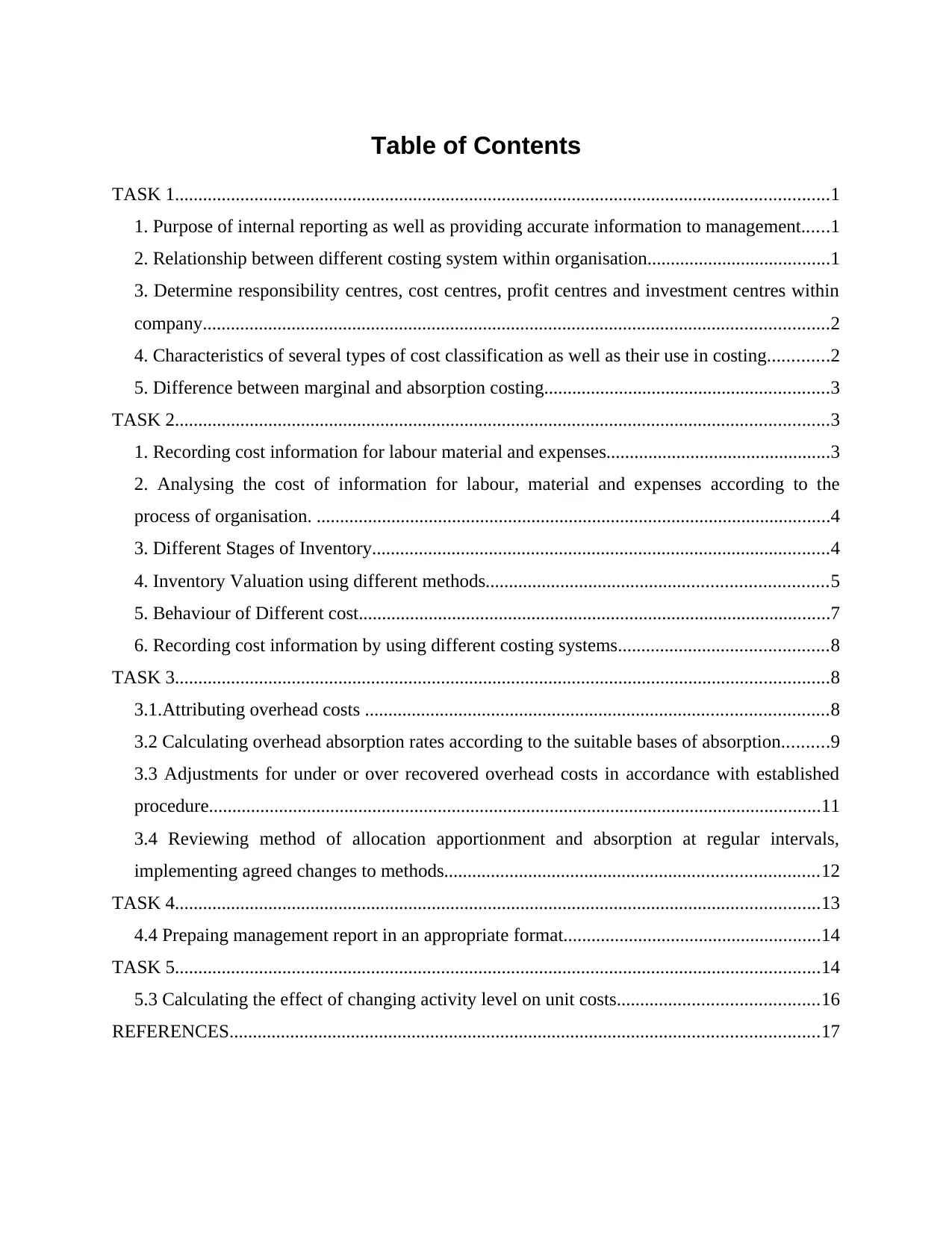
Table of Contents
TASK 1............................................................................................................................................1
1. Purpose of internal reporting as well as providing accurate information to management......1
2. Relationship between different costing system within organisation.......................................1
3. Determine responsibility centres, cost centres, profit centres and investment centres within
company......................................................................................................................................2
4. Characteristics of several types of cost classification as well as their use in costing.............2
5. Difference between marginal and absorption costing.............................................................3
TASK 2............................................................................................................................................3
1. Recording cost information for labour material and expenses................................................3
2. Analysing the cost of information for labour, material and expenses according to the
process of organisation. ..............................................................................................................4
3. Different Stages of Inventory..................................................................................................4
4. Inventory Valuation using different methods.........................................................................5
5. Behaviour of Different cost.....................................................................................................7
6. Recording cost information by using different costing systems.............................................8
TASK 3............................................................................................................................................8
3.1.Attributing overhead costs ...................................................................................................8
3.2 Calculating overhead absorption rates according to the suitable bases of absorption..........9
3.3 Adjustments for under or over recovered overhead costs in accordance with established
procedure...................................................................................................................................11
3.4 Reviewing method of allocation apportionment and absorption at regular intervals,
implementing agreed changes to methods................................................................................12
TASK 4..........................................................................................................................................13
4.4 Prepaing management report in an appropriate format.......................................................14
TASK 5..........................................................................................................................................14
5.3 Calculating the effect of changing activity level on unit costs...........................................16
REFERENCES..............................................................................................................................17
TASK 1............................................................................................................................................1
1. Purpose of internal reporting as well as providing accurate information to management......1
2. Relationship between different costing system within organisation.......................................1
3. Determine responsibility centres, cost centres, profit centres and investment centres within
company......................................................................................................................................2
4. Characteristics of several types of cost classification as well as their use in costing.............2
5. Difference between marginal and absorption costing.............................................................3
TASK 2............................................................................................................................................3
1. Recording cost information for labour material and expenses................................................3
2. Analysing the cost of information for labour, material and expenses according to the
process of organisation. ..............................................................................................................4
3. Different Stages of Inventory..................................................................................................4
4. Inventory Valuation using different methods.........................................................................5
5. Behaviour of Different cost.....................................................................................................7
6. Recording cost information by using different costing systems.............................................8
TASK 3............................................................................................................................................8
3.1.Attributing overhead costs ...................................................................................................8
3.2 Calculating overhead absorption rates according to the suitable bases of absorption..........9
3.3 Adjustments for under or over recovered overhead costs in accordance with established
procedure...................................................................................................................................11
3.4 Reviewing method of allocation apportionment and absorption at regular intervals,
implementing agreed changes to methods................................................................................12
TASK 4..........................................................................................................................................13
4.4 Prepaing management report in an appropriate format.......................................................14
TASK 5..........................................................................................................................................14
5.3 Calculating the effect of changing activity level on unit costs...........................................16
REFERENCES..............................................................................................................................17
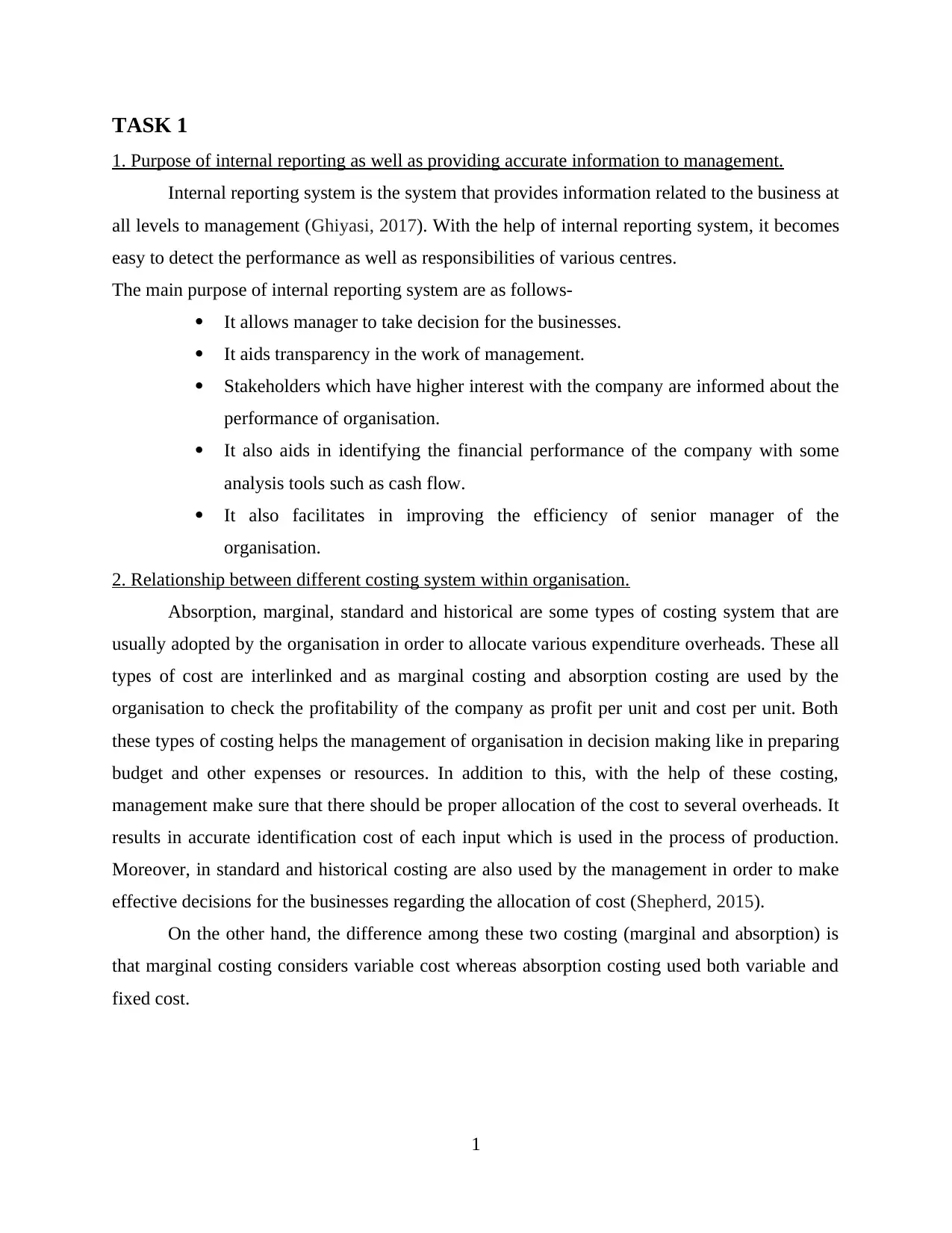
TASK 1
1. Purpose of internal reporting as well as providing accurate information to management.
Internal reporting system is the system that provides information related to the business at
all levels to management (Ghiyasi, 2017). With the help of internal reporting system, it becomes
easy to detect the performance as well as responsibilities of various centres.
The main purpose of internal reporting system are as follows-
It allows manager to take decision for the businesses.
It aids transparency in the work of management.
Stakeholders which have higher interest with the company are informed about the
performance of organisation.
It also aids in identifying the financial performance of the company with some
analysis tools such as cash flow.
It also facilitates in improving the efficiency of senior manager of the
organisation.
2. Relationship between different costing system within organisation.
Absorption, marginal, standard and historical are some types of costing system that are
usually adopted by the organisation in order to allocate various expenditure overheads. These all
types of cost are interlinked and as marginal costing and absorption costing are used by the
organisation to check the profitability of the company as profit per unit and cost per unit. Both
these types of costing helps the management of organisation in decision making like in preparing
budget and other expenses or resources. In addition to this, with the help of these costing,
management make sure that there should be proper allocation of the cost to several overheads. It
results in accurate identification cost of each input which is used in the process of production.
Moreover, in standard and historical costing are also used by the management in order to make
effective decisions for the businesses regarding the allocation of cost (Shepherd, 2015).
On the other hand, the difference among these two costing (marginal and absorption) is
that marginal costing considers variable cost whereas absorption costing used both variable and
fixed cost.
1
1. Purpose of internal reporting as well as providing accurate information to management.
Internal reporting system is the system that provides information related to the business at
all levels to management (Ghiyasi, 2017). With the help of internal reporting system, it becomes
easy to detect the performance as well as responsibilities of various centres.
The main purpose of internal reporting system are as follows-
It allows manager to take decision for the businesses.
It aids transparency in the work of management.
Stakeholders which have higher interest with the company are informed about the
performance of organisation.
It also aids in identifying the financial performance of the company with some
analysis tools such as cash flow.
It also facilitates in improving the efficiency of senior manager of the
organisation.
2. Relationship between different costing system within organisation.
Absorption, marginal, standard and historical are some types of costing system that are
usually adopted by the organisation in order to allocate various expenditure overheads. These all
types of cost are interlinked and as marginal costing and absorption costing are used by the
organisation to check the profitability of the company as profit per unit and cost per unit. Both
these types of costing helps the management of organisation in decision making like in preparing
budget and other expenses or resources. In addition to this, with the help of these costing,
management make sure that there should be proper allocation of the cost to several overheads. It
results in accurate identification cost of each input which is used in the process of production.
Moreover, in standard and historical costing are also used by the management in order to make
effective decisions for the businesses regarding the allocation of cost (Shepherd, 2015).
On the other hand, the difference among these two costing (marginal and absorption) is
that marginal costing considers variable cost whereas absorption costing used both variable and
fixed cost.
1
⊘ This is a preview!⊘
Do you want full access?
Subscribe today to unlock all pages.

Trusted by 1+ million students worldwide
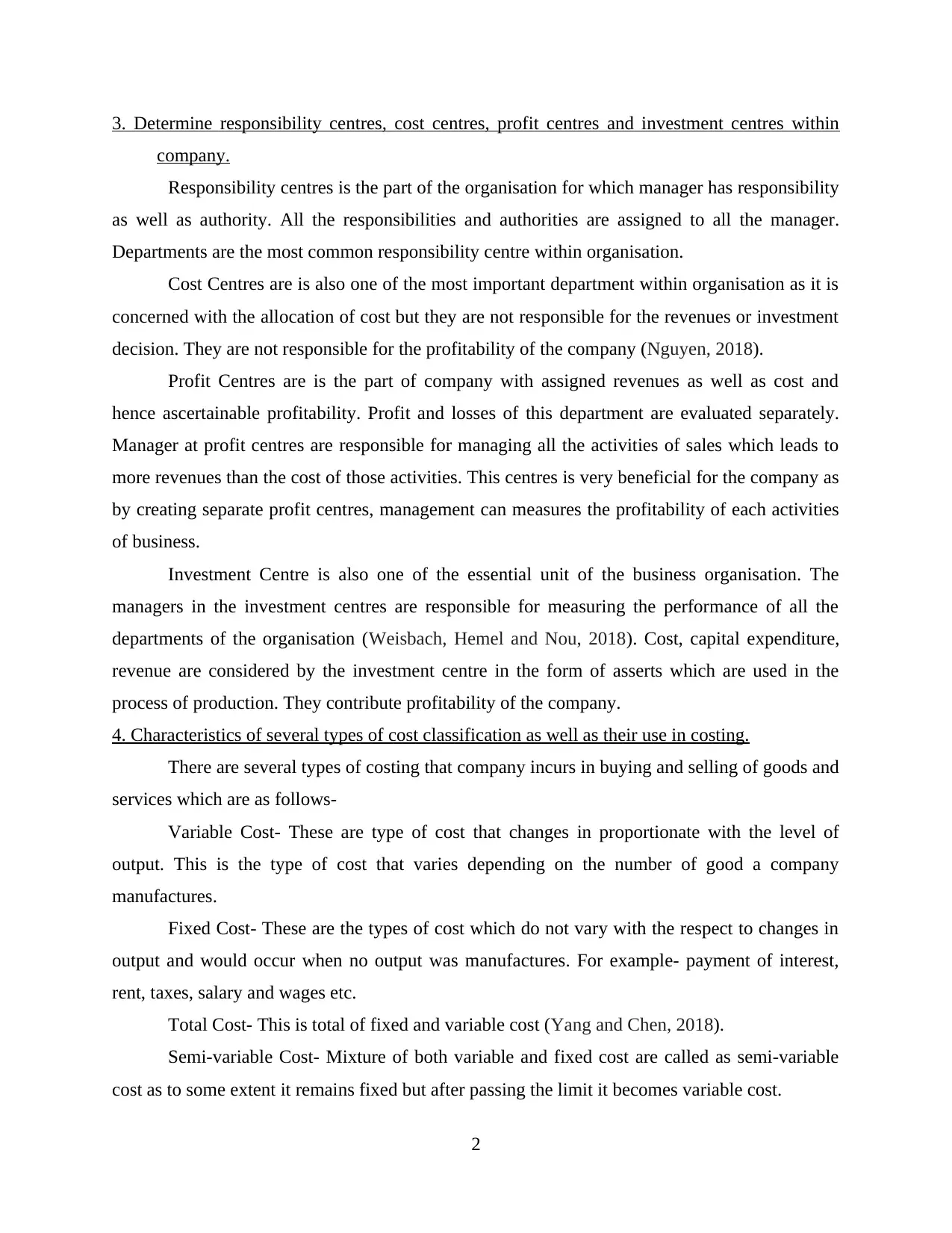
3. Determine responsibility centres, cost centres, profit centres and investment centres within
company.
Responsibility centres is the part of the organisation for which manager has responsibility
as well as authority. All the responsibilities and authorities are assigned to all the manager.
Departments are the most common responsibility centre within organisation.
Cost Centres are is also one of the most important department within organisation as it is
concerned with the allocation of cost but they are not responsible for the revenues or investment
decision. They are not responsible for the profitability of the company (Nguyen, 2018).
Profit Centres are is the part of company with assigned revenues as well as cost and
hence ascertainable profitability. Profit and losses of this department are evaluated separately.
Manager at profit centres are responsible for managing all the activities of sales which leads to
more revenues than the cost of those activities. This centres is very beneficial for the company as
by creating separate profit centres, management can measures the profitability of each activities
of business.
Investment Centre is also one of the essential unit of the business organisation. The
managers in the investment centres are responsible for measuring the performance of all the
departments of the organisation (Weisbach, Hemel and Nou, 2018). Cost, capital expenditure,
revenue are considered by the investment centre in the form of asserts which are used in the
process of production. They contribute profitability of the company.
4. Characteristics of several types of cost classification as well as their use in costing.
There are several types of costing that company incurs in buying and selling of goods and
services which are as follows-
Variable Cost- These are type of cost that changes in proportionate with the level of
output. This is the type of cost that varies depending on the number of good a company
manufactures.
Fixed Cost- These are the types of cost which do not vary with the respect to changes in
output and would occur when no output was manufactures. For example- payment of interest,
rent, taxes, salary and wages etc.
Total Cost- This is total of fixed and variable cost (Yang and Chen, 2018).
Semi-variable Cost- Mixture of both variable and fixed cost are called as semi-variable
cost as to some extent it remains fixed but after passing the limit it becomes variable cost.
2
company.
Responsibility centres is the part of the organisation for which manager has responsibility
as well as authority. All the responsibilities and authorities are assigned to all the manager.
Departments are the most common responsibility centre within organisation.
Cost Centres are is also one of the most important department within organisation as it is
concerned with the allocation of cost but they are not responsible for the revenues or investment
decision. They are not responsible for the profitability of the company (Nguyen, 2018).
Profit Centres are is the part of company with assigned revenues as well as cost and
hence ascertainable profitability. Profit and losses of this department are evaluated separately.
Manager at profit centres are responsible for managing all the activities of sales which leads to
more revenues than the cost of those activities. This centres is very beneficial for the company as
by creating separate profit centres, management can measures the profitability of each activities
of business.
Investment Centre is also one of the essential unit of the business organisation. The
managers in the investment centres are responsible for measuring the performance of all the
departments of the organisation (Weisbach, Hemel and Nou, 2018). Cost, capital expenditure,
revenue are considered by the investment centre in the form of asserts which are used in the
process of production. They contribute profitability of the company.
4. Characteristics of several types of cost classification as well as their use in costing.
There are several types of costing that company incurs in buying and selling of goods and
services which are as follows-
Variable Cost- These are type of cost that changes in proportionate with the level of
output. This is the type of cost that varies depending on the number of good a company
manufactures.
Fixed Cost- These are the types of cost which do not vary with the respect to changes in
output and would occur when no output was manufactures. For example- payment of interest,
rent, taxes, salary and wages etc.
Total Cost- This is total of fixed and variable cost (Yang and Chen, 2018).
Semi-variable Cost- Mixture of both variable and fixed cost are called as semi-variable
cost as to some extent it remains fixed but after passing the limit it becomes variable cost.
2
Paraphrase This Document
Need a fresh take? Get an instant paraphrase of this document with our AI Paraphraser
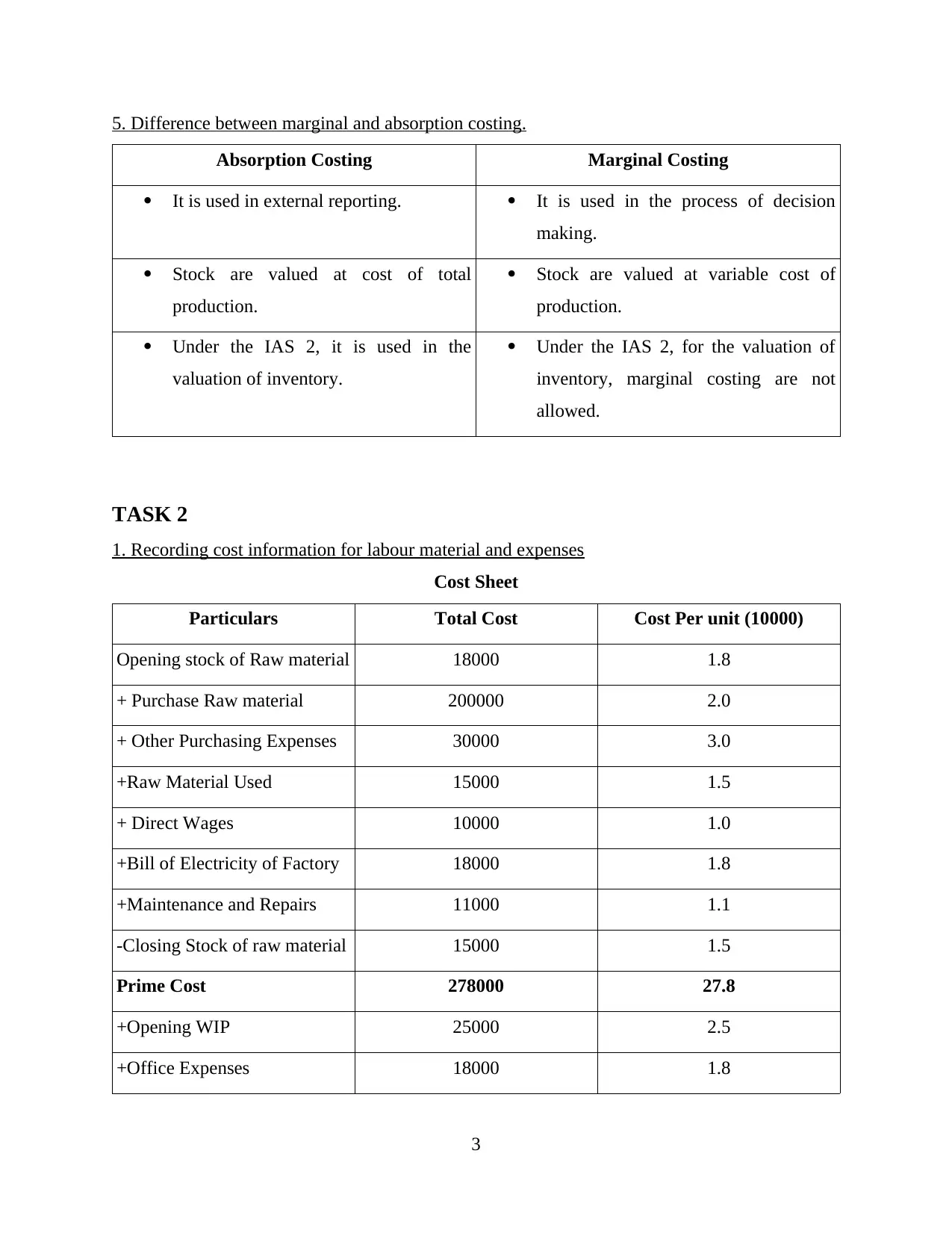
5. Difference between marginal and absorption costing.
Absorption Costing Marginal Costing
It is used in external reporting. It is used in the process of decision
making.
Stock are valued at cost of total
production.
Stock are valued at variable cost of
production.
Under the IAS 2, it is used in the
valuation of inventory.
Under the IAS 2, for the valuation of
inventory, marginal costing are not
allowed.
TASK 2
1. Recording cost information for labour material and expenses
Cost Sheet
Particulars Total Cost Cost Per unit (10000)
Opening stock of Raw material 18000 1.8
+ Purchase Raw material 200000 2.0
+ Other Purchasing Expenses 30000 3.0
+Raw Material Used 15000 1.5
+ Direct Wages 10000 1.0
+Bill of Electricity of Factory 18000 1.8
+Maintenance and Repairs 11000 1.1
-Closing Stock of raw material 15000 1.5
Prime Cost 278000 27.8
+Opening WIP 25000 2.5
+Office Expenses 18000 1.8
3
Absorption Costing Marginal Costing
It is used in external reporting. It is used in the process of decision
making.
Stock are valued at cost of total
production.
Stock are valued at variable cost of
production.
Under the IAS 2, it is used in the
valuation of inventory.
Under the IAS 2, for the valuation of
inventory, marginal costing are not
allowed.
TASK 2
1. Recording cost information for labour material and expenses
Cost Sheet
Particulars Total Cost Cost Per unit (10000)
Opening stock of Raw material 18000 1.8
+ Purchase Raw material 200000 2.0
+ Other Purchasing Expenses 30000 3.0
+Raw Material Used 15000 1.5
+ Direct Wages 10000 1.0
+Bill of Electricity of Factory 18000 1.8
+Maintenance and Repairs 11000 1.1
-Closing Stock of raw material 15000 1.5
Prime Cost 278000 27.8
+Opening WIP 25000 2.5
+Office Expenses 18000 1.8
3
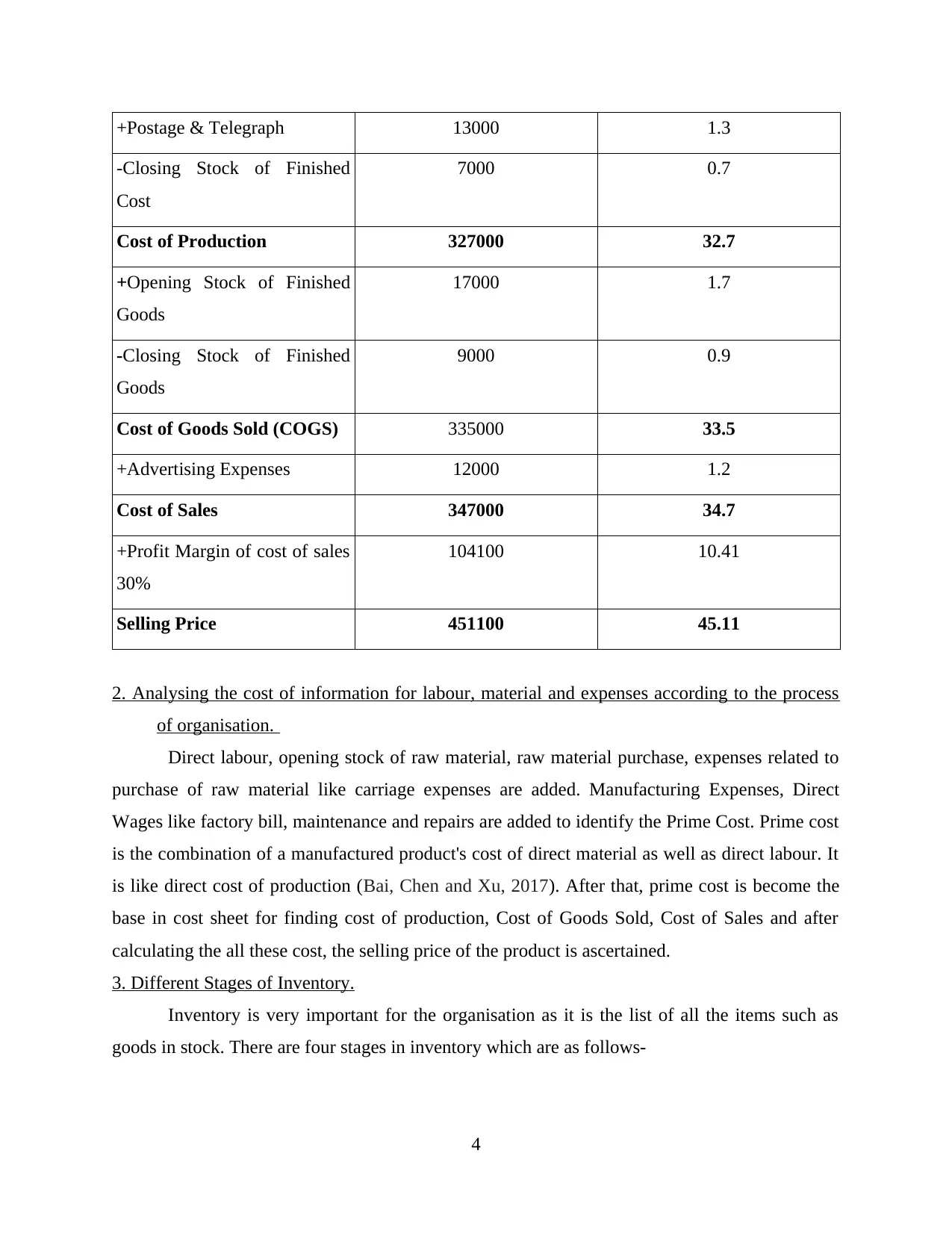
+Postage & Telegraph 13000 1.3
-Closing Stock of Finished
Cost
7000 0.7
Cost of Production 327000 32.7
+Opening Stock of Finished
Goods
17000 1.7
-Closing Stock of Finished
Goods
9000 0.9
Cost of Goods Sold (COGS) 335000 33.5
+Advertising Expenses 12000 1.2
Cost of Sales 347000 34.7
+Profit Margin of cost of sales
30%
104100 10.41
Selling Price 451100 45.11
2. Analysing the cost of information for labour, material and expenses according to the process
of organisation.
Direct labour, opening stock of raw material, raw material purchase, expenses related to
purchase of raw material like carriage expenses are added. Manufacturing Expenses, Direct
Wages like factory bill, maintenance and repairs are added to identify the Prime Cost. Prime cost
is the combination of a manufactured product's cost of direct material as well as direct labour. It
is like direct cost of production (Bai, Chen and Xu, 2017). After that, prime cost is become the
base in cost sheet for finding cost of production, Cost of Goods Sold, Cost of Sales and after
calculating the all these cost, the selling price of the product is ascertained.
3. Different Stages of Inventory.
Inventory is very important for the organisation as it is the list of all the items such as
goods in stock. There are four stages in inventory which are as follows-
4
-Closing Stock of Finished
Cost
7000 0.7
Cost of Production 327000 32.7
+Opening Stock of Finished
Goods
17000 1.7
-Closing Stock of Finished
Goods
9000 0.9
Cost of Goods Sold (COGS) 335000 33.5
+Advertising Expenses 12000 1.2
Cost of Sales 347000 34.7
+Profit Margin of cost of sales
30%
104100 10.41
Selling Price 451100 45.11
2. Analysing the cost of information for labour, material and expenses according to the process
of organisation.
Direct labour, opening stock of raw material, raw material purchase, expenses related to
purchase of raw material like carriage expenses are added. Manufacturing Expenses, Direct
Wages like factory bill, maintenance and repairs are added to identify the Prime Cost. Prime cost
is the combination of a manufactured product's cost of direct material as well as direct labour. It
is like direct cost of production (Bai, Chen and Xu, 2017). After that, prime cost is become the
base in cost sheet for finding cost of production, Cost of Goods Sold, Cost of Sales and after
calculating the all these cost, the selling price of the product is ascertained.
3. Different Stages of Inventory.
Inventory is very important for the organisation as it is the list of all the items such as
goods in stock. There are four stages in inventory which are as follows-
4
⊘ This is a preview!⊘
Do you want full access?
Subscribe today to unlock all pages.

Trusted by 1+ million students worldwide
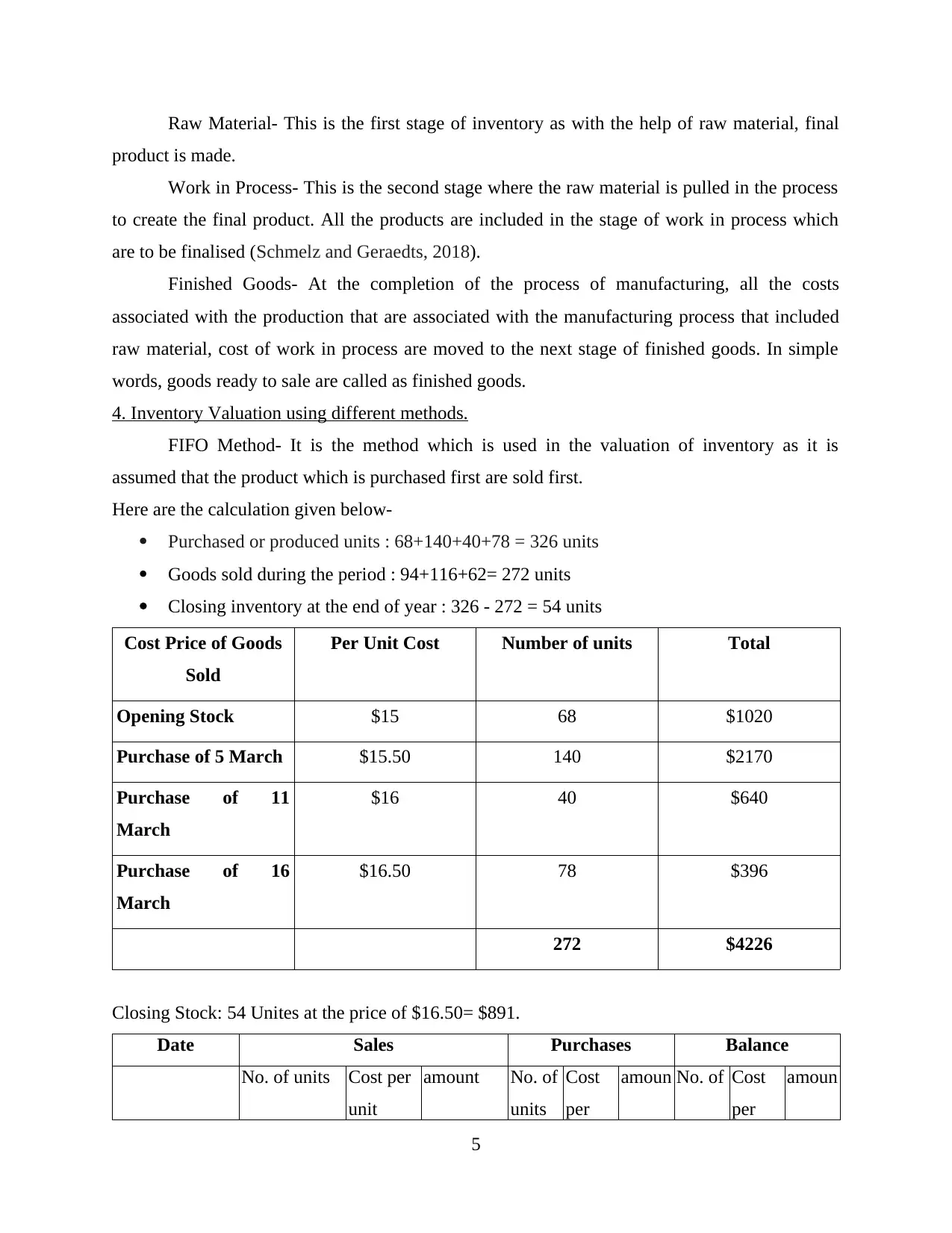
Raw Material- This is the first stage of inventory as with the help of raw material, final
product is made.
Work in Process- This is the second stage where the raw material is pulled in the process
to create the final product. All the products are included in the stage of work in process which
are to be finalised (Schmelz and Geraedts, 2018).
Finished Goods- At the completion of the process of manufacturing, all the costs
associated with the production that are associated with the manufacturing process that included
raw material, cost of work in process are moved to the next stage of finished goods. In simple
words, goods ready to sale are called as finished goods.
4. Inventory Valuation using different methods.
FIFO Method- It is the method which is used in the valuation of inventory as it is
assumed that the product which is purchased first are sold first.
Here are the calculation given below-
Purchased or produced units : 68+140+40+78 = 326 units
Goods sold during the period : 94+116+62= 272 units
Closing inventory at the end of year : 326 - 272 = 54 units
Cost Price of Goods
Sold
Per Unit Cost Number of units Total
Opening Stock $15 68 $1020
Purchase of 5 March $15.50 140 $2170
Purchase of 11
March
$16 40 $640
Purchase of 16
March
$16.50 78 $396
272 $4226
Closing Stock: 54 Unites at the price of $16.50= $891.
Date Sales Purchases Balance
No. of units Cost per
unit
amount No. of
units
Cost
per
amoun No. of Cost
per
amoun
5
product is made.
Work in Process- This is the second stage where the raw material is pulled in the process
to create the final product. All the products are included in the stage of work in process which
are to be finalised (Schmelz and Geraedts, 2018).
Finished Goods- At the completion of the process of manufacturing, all the costs
associated with the production that are associated with the manufacturing process that included
raw material, cost of work in process are moved to the next stage of finished goods. In simple
words, goods ready to sale are called as finished goods.
4. Inventory Valuation using different methods.
FIFO Method- It is the method which is used in the valuation of inventory as it is
assumed that the product which is purchased first are sold first.
Here are the calculation given below-
Purchased or produced units : 68+140+40+78 = 326 units
Goods sold during the period : 94+116+62= 272 units
Closing inventory at the end of year : 326 - 272 = 54 units
Cost Price of Goods
Sold
Per Unit Cost Number of units Total
Opening Stock $15 68 $1020
Purchase of 5 March $15.50 140 $2170
Purchase of 11
March
$16 40 $640
Purchase of 16
March
$16.50 78 $396
272 $4226
Closing Stock: 54 Unites at the price of $16.50= $891.
Date Sales Purchases Balance
No. of units Cost per
unit
amount No. of
units
Cost
per
amoun No. of Cost
per
amoun
5
Paraphrase This Document
Need a fresh take? Get an instant paraphrase of this document with our AI Paraphraser
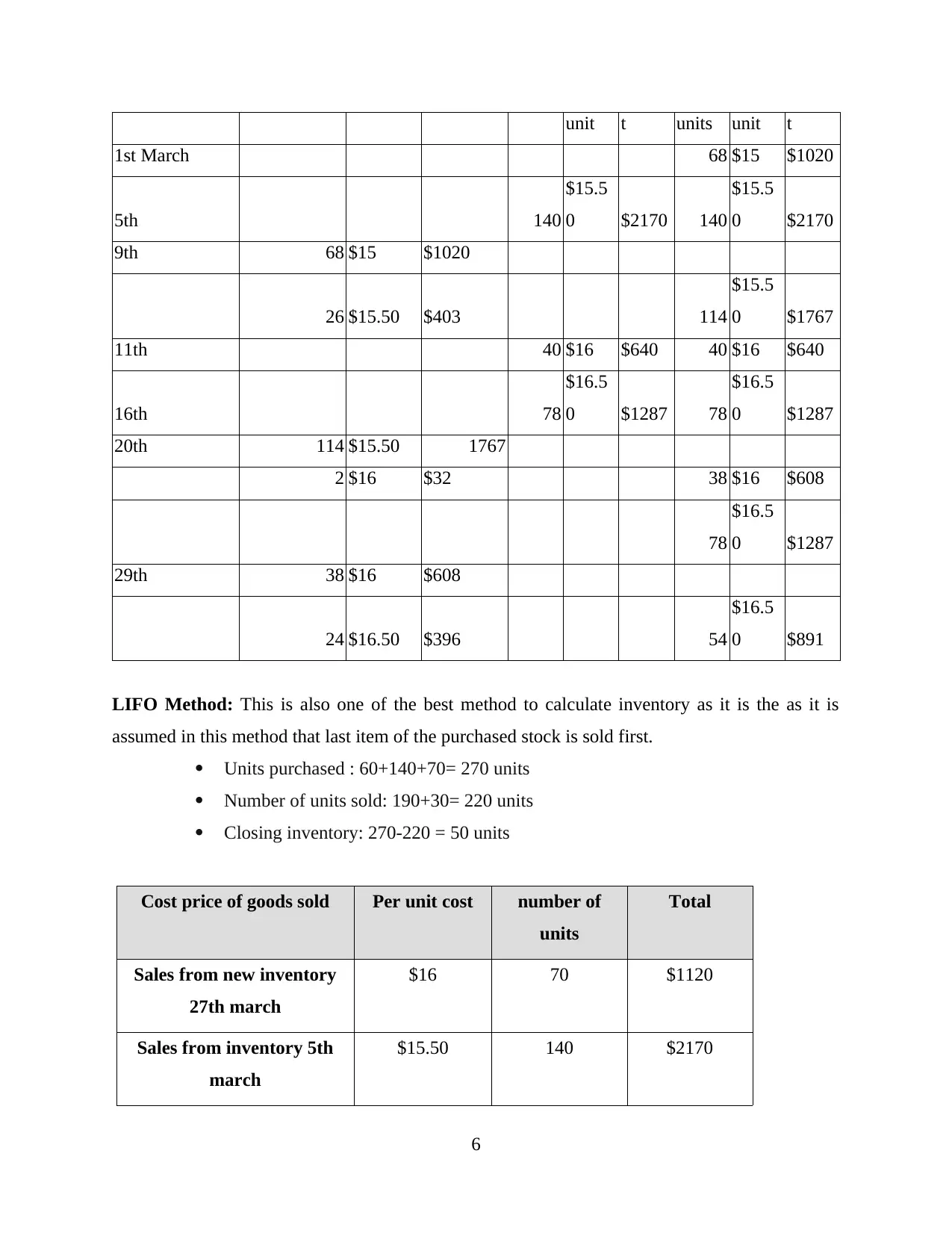
unit t units unit t
1st March 68 $15 $1020
5th 140
$15.5
0 $2170 140
$15.5
0 $2170
9th 68 $15 $1020
26 $15.50 $403 114
$15.5
0 $1767
11th 40 $16 $640 40 $16 $640
16th 78
$16.5
0 $1287 78
$16.5
0 $1287
20th 114 $15.50 1767
2 $16 $32 38 $16 $608
78
$16.5
0 $1287
29th 38 $16 $608
24 $16.50 $396 54
$16.5
0 $891
LIFO Method: This is also one of the best method to calculate inventory as it is the as it is
assumed in this method that last item of the purchased stock is sold first.
Units purchased : 60+140+70= 270 units
Number of units sold: 190+30= 220 units
Closing inventory: 270-220 = 50 units
Cost price of goods sold Per unit cost number of
units
Total
Sales from new inventory
27th march
$16 70 $1120
Sales from inventory 5th
march
$15.50 140 $2170
6
1st March 68 $15 $1020
5th 140
$15.5
0 $2170 140
$15.5
0 $2170
9th 68 $15 $1020
26 $15.50 $403 114
$15.5
0 $1767
11th 40 $16 $640 40 $16 $640
16th 78
$16.5
0 $1287 78
$16.5
0 $1287
20th 114 $15.50 1767
2 $16 $32 38 $16 $608
78
$16.5
0 $1287
29th 38 $16 $608
24 $16.50 $396 54
$16.5
0 $891
LIFO Method: This is also one of the best method to calculate inventory as it is the as it is
assumed in this method that last item of the purchased stock is sold first.
Units purchased : 60+140+70= 270 units
Number of units sold: 190+30= 220 units
Closing inventory: 270-220 = 50 units
Cost price of goods sold Per unit cost number of
units
Total
Sales from new inventory
27th march
$16 70 $1120
Sales from inventory 5th
march
$15.50 140 $2170
6
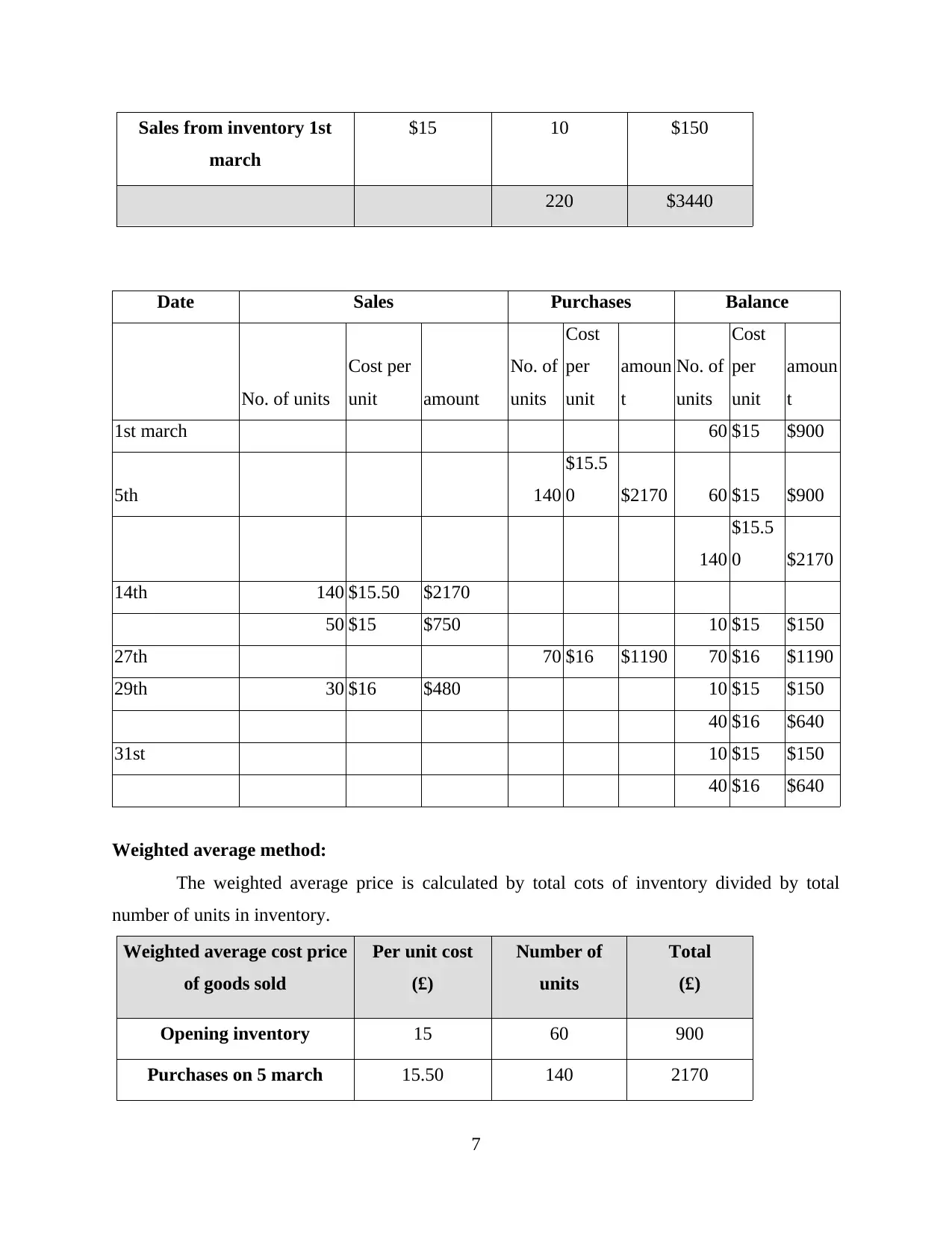
Sales from inventory 1st
march
$15 10 $150
220 $3440
Date Sales Purchases Balance
No. of units
Cost per
unit amount
No. of
units
Cost
per
unit
amoun
t
No. of
units
Cost
per
unit
amoun
t
1st march 60 $15 $900
5th 140
$15.5
0 $2170 60 $15 $900
140
$15.5
0 $2170
14th 140 $15.50 $2170
50 $15 $750 10 $15 $150
27th 70 $16 $1190 70 $16 $1190
29th 30 $16 $480 10 $15 $150
40 $16 $640
31st 10 $15 $150
40 $16 $640
Weighted average method:
The weighted average price is calculated by total cots of inventory divided by total
number of units in inventory.
Weighted average cost price
of goods sold
Per unit cost
(£)
Number of
units
Total
(£)
Opening inventory 15 60 900
Purchases on 5 march 15.50 140 2170
7
march
$15 10 $150
220 $3440
Date Sales Purchases Balance
No. of units
Cost per
unit amount
No. of
units
Cost
per
unit
amoun
t
No. of
units
Cost
per
unit
amoun
t
1st march 60 $15 $900
5th 140
$15.5
0 $2170 60 $15 $900
140
$15.5
0 $2170
14th 140 $15.50 $2170
50 $15 $750 10 $15 $150
27th 70 $16 $1190 70 $16 $1190
29th 30 $16 $480 10 $15 $150
40 $16 $640
31st 10 $15 $150
40 $16 $640
Weighted average method:
The weighted average price is calculated by total cots of inventory divided by total
number of units in inventory.
Weighted average cost price
of goods sold
Per unit cost
(£)
Number of
units
Total
(£)
Opening inventory 15 60 900
Purchases on 5 march 15.50 140 2170
7
⊘ This is a preview!⊘
Do you want full access?
Subscribe today to unlock all pages.

Trusted by 1+ million students worldwide
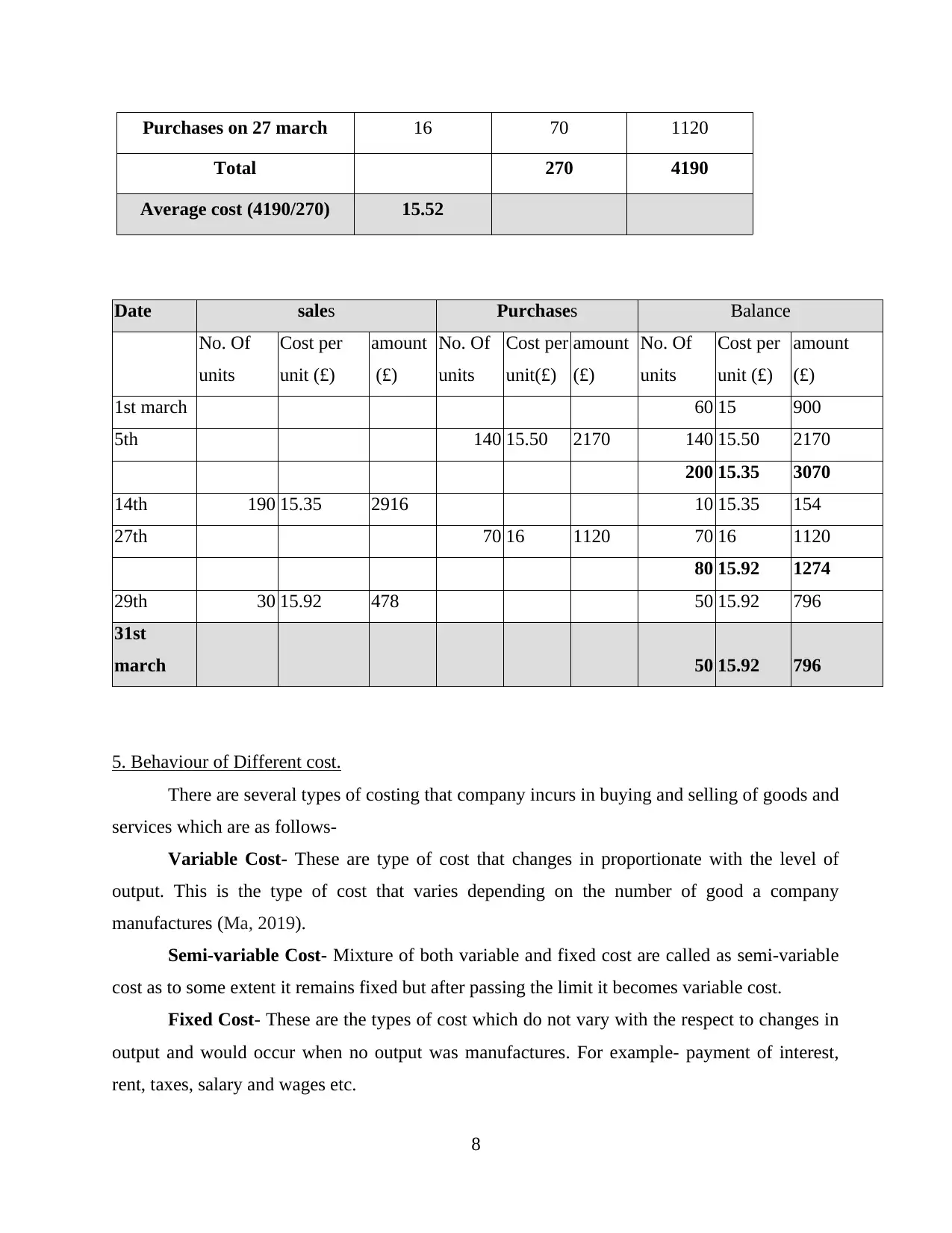
Purchases on 27 march 16 70 1120
Total 270 4190
Average cost (4190/270) 15.52
Date sales Purchases Balance
No. Of
units
Cost per
unit (£)
amount
(£)
No. Of
units
Cost per
unit(£)
amount
(£)
No. Of
units
Cost per
unit (£)
amount
(£)
1st march 60 15 900
5th 140 15.50 2170 140 15.50 2170
200 15.35 3070
14th 190 15.35 2916 10 15.35 154
27th 70 16 1120 70 16 1120
80 15.92 1274
29th 30 15.92 478 50 15.92 796
31st
march 50 15.92 796
5. Behaviour of Different cost.
There are several types of costing that company incurs in buying and selling of goods and
services which are as follows-
Variable Cost- These are type of cost that changes in proportionate with the level of
output. This is the type of cost that varies depending on the number of good a company
manufactures (Ma, 2019).
Semi-variable Cost- Mixture of both variable and fixed cost are called as semi-variable
cost as to some extent it remains fixed but after passing the limit it becomes variable cost.
Fixed Cost- These are the types of cost which do not vary with the respect to changes in
output and would occur when no output was manufactures. For example- payment of interest,
rent, taxes, salary and wages etc.
8
Total 270 4190
Average cost (4190/270) 15.52
Date sales Purchases Balance
No. Of
units
Cost per
unit (£)
amount
(£)
No. Of
units
Cost per
unit(£)
amount
(£)
No. Of
units
Cost per
unit (£)
amount
(£)
1st march 60 15 900
5th 140 15.50 2170 140 15.50 2170
200 15.35 3070
14th 190 15.35 2916 10 15.35 154
27th 70 16 1120 70 16 1120
80 15.92 1274
29th 30 15.92 478 50 15.92 796
31st
march 50 15.92 796
5. Behaviour of Different cost.
There are several types of costing that company incurs in buying and selling of goods and
services which are as follows-
Variable Cost- These are type of cost that changes in proportionate with the level of
output. This is the type of cost that varies depending on the number of good a company
manufactures (Ma, 2019).
Semi-variable Cost- Mixture of both variable and fixed cost are called as semi-variable
cost as to some extent it remains fixed but after passing the limit it becomes variable cost.
Fixed Cost- These are the types of cost which do not vary with the respect to changes in
output and would occur when no output was manufactures. For example- payment of interest,
rent, taxes, salary and wages etc.
8
Paraphrase This Document
Need a fresh take? Get an instant paraphrase of this document with our AI Paraphraser
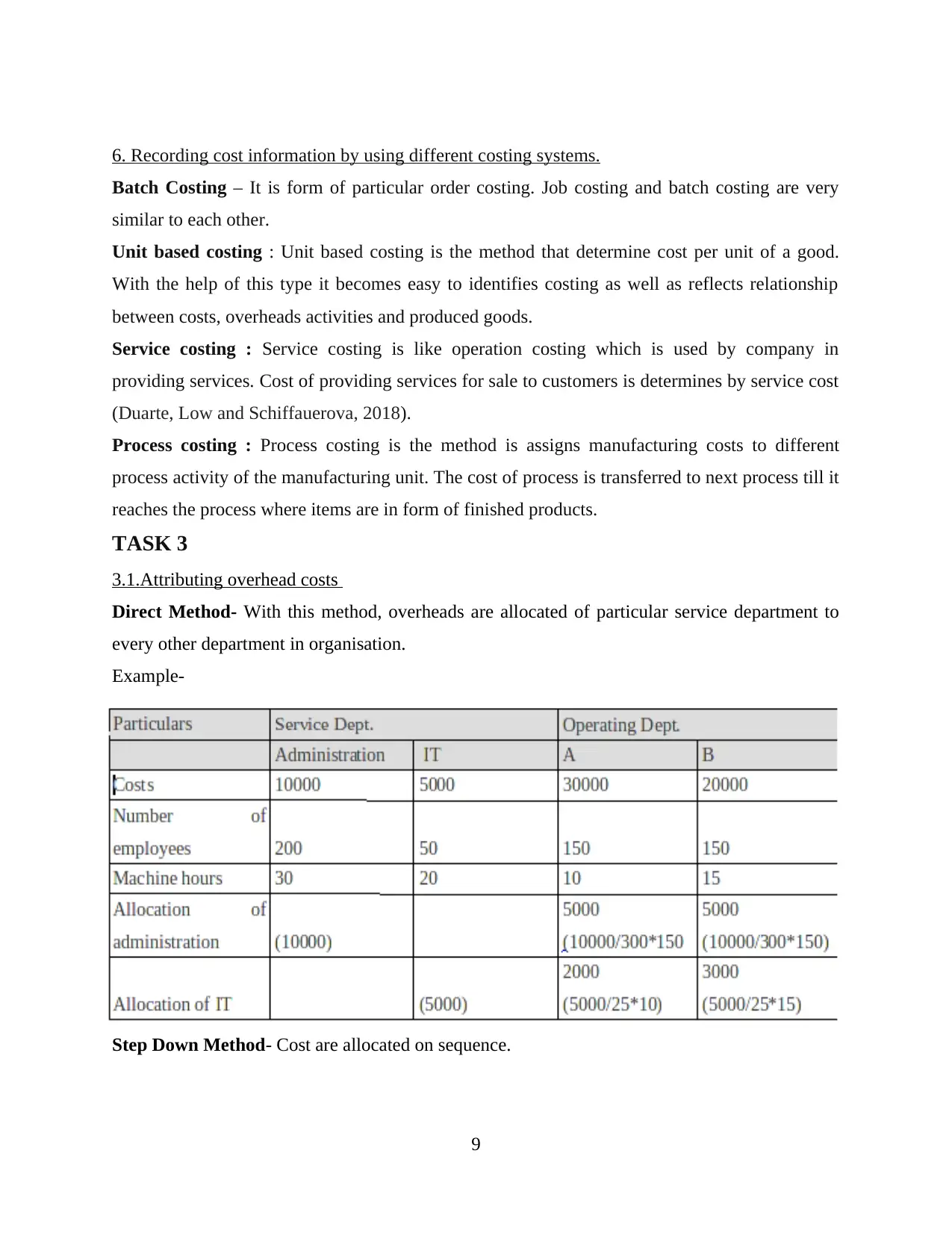
6. Recording cost information by using different costing systems.
Batch Costing – It is form of particular order costing. Job costing and batch costing are very
similar to each other.
Unit based costing : Unit based costing is the method that determine cost per unit of a good.
With the help of this type it becomes easy to identifies costing as well as reflects relationship
between costs, overheads activities and produced goods.
Service costing : Service costing is like operation costing which is used by company in
providing services. Cost of providing services for sale to customers is determines by service cost
(Duarte, Low and Schiffauerova, 2018).
Process costing : Process costing is the method is assigns manufacturing costs to different
process activity of the manufacturing unit. The cost of process is transferred to next process till it
reaches the process where items are in form of finished products.
TASK 3
3.1.Attributing overhead costs
Direct Method- With this method, overheads are allocated of particular service department to
every other department in organisation.
Example-
Step Down Method- Cost are allocated on sequence.
9
Batch Costing – It is form of particular order costing. Job costing and batch costing are very
similar to each other.
Unit based costing : Unit based costing is the method that determine cost per unit of a good.
With the help of this type it becomes easy to identifies costing as well as reflects relationship
between costs, overheads activities and produced goods.
Service costing : Service costing is like operation costing which is used by company in
providing services. Cost of providing services for sale to customers is determines by service cost
(Duarte, Low and Schiffauerova, 2018).
Process costing : Process costing is the method is assigns manufacturing costs to different
process activity of the manufacturing unit. The cost of process is transferred to next process till it
reaches the process where items are in form of finished products.
TASK 3
3.1.Attributing overhead costs
Direct Method- With this method, overheads are allocated of particular service department to
every other department in organisation.
Example-
Step Down Method- Cost are allocated on sequence.
9
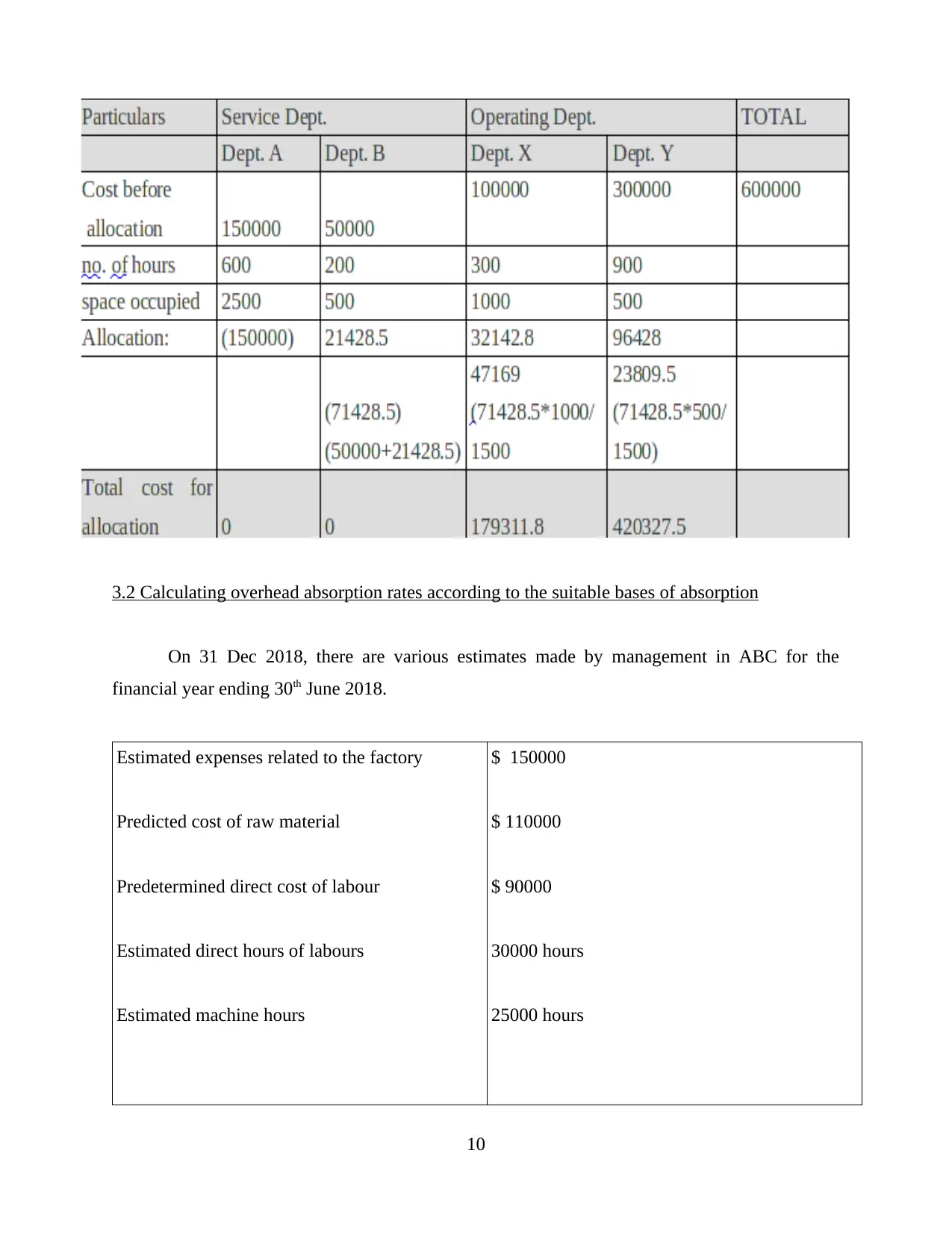
3.2 Calculating overhead absorption rates according to the suitable bases of absorption
On 31 Dec 2018, there are various estimates made by management in ABC for the
financial year ending 30th June 2018.
Estimated expenses related to the factory
Predicted cost of raw material
Predetermined direct cost of labour
Estimated direct hours of labours
Estimated machine hours
$ 150000
$ 110000
$ 90000
30000 hours
25000 hours
10
On 31 Dec 2018, there are various estimates made by management in ABC for the
financial year ending 30th June 2018.
Estimated expenses related to the factory
Predicted cost of raw material
Predetermined direct cost of labour
Estimated direct hours of labours
Estimated machine hours
$ 150000
$ 110000
$ 90000
30000 hours
25000 hours
10
⊘ This is a preview!⊘
Do you want full access?
Subscribe today to unlock all pages.

Trusted by 1+ million students worldwide
1 out of 21
Related Documents
Your All-in-One AI-Powered Toolkit for Academic Success.
+13062052269
info@desklib.com
Available 24*7 on WhatsApp / Email
![[object Object]](/_next/static/media/star-bottom.7253800d.svg)
Unlock your academic potential
Copyright © 2020–2025 A2Z Services. All Rights Reserved. Developed and managed by ZUCOL.





